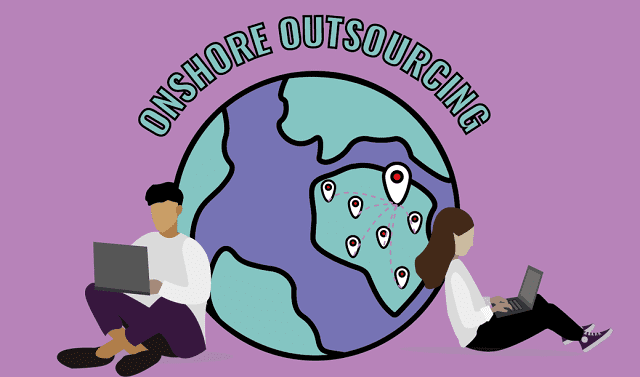Сompanies frequently resort to IT outsourcing services to save costs, increase efficiency, and access specialist talents. As firms consider outsourcing, one critical choice is identifying the best model for their requirements.
Let’s examine the differences between onshore, offshore, and nearshore IT outsourcing, answering essential issues to help organizations make educated decisions.
Understanding IT Outsourcing Services
Before looking at the various outsourcing models, it’s essential to grasp the broader concept of IT outsourcing services.
These services encompass delegating specific IT functions to external service providers, allowing organizations to focus on core competencies while benefiting from the expertise and resources of specialized partners.
Onshore IT Outsourcing: Proximity and Collaboration

What is Onshore IT Outsourcing, and How does It Work?
Onshore IT outsourcing involves contracting services to a third-party provider within the same country as the client organization.
Proximity is a key advantage, fostering easier communication, collaboration, and alignment with local regulations.
This model suits businesses that prefer real-time interactions and a shared cultural understanding.
Advantages of Onshore IT Outsourcing
- Cultural alignment. Shared language and cultural nuances can facilitate smoother collaboration.
- Regulatory compliance. Onshore providers often adhere to the same regulatory framework, reducing compliance challenges.
- Time zone consistency. Operating in the same time zone streamlines coordination and responsiveness.
Considerations for Onshore IT Outsourcing
- Cost implications. Onshore services may be relatively more expensive than offshore alternatives.
- Resource availability. Depending on the region, onshore providers may face talent shortages in specific skill sets.
- Market saturation. Competition for skilled IT professionals in highly developed regions can lead to higher costs and limited availability.
Offshore IT Outsourcing: Global Reach and Cost Efficiency

How does offshore IT outsourcing differ, and when is it suitable?
Offshore IT outsourcing involves contracting services to a provider in a different country, often characterized by significant geographical and time zone differences.
This model is renowned for its cost efficiency and access to a diverse talent pool.
Advantages of offshore IT outsourcing
- Cost savings. Offshore providers may offer competitive rates, making it an attractive option for budget-conscious organizations.
- Global talent pool. Access to a broader range of skilled professionals, including those with specialized expertise.
- 24/7 operations. Time zone differences can be advantageous, allowing for continuous project work and faster turnaround times.
- Diverse perspectives. Working with teams from different cultural backgrounds can bring diverse perspectives and innovative solutions.
Considerations for offshore IT outsourcing
- Communication challenges. Time zone variations might cause delays in interaction and misunderstandings.
- Cultural variations. Differing cultural norms can impact collaboration and project understanding.
- Data security and compliance. Different countries may have varying data protection regulations, requiring careful consideration of compliance issues.
Nearshore IT Outsourcing: Balancing Proximity and Cost

What Defines Nearshore IT Outsourcing, and When is It a Suitable Choice?
Nearshore IT outsourcing balances onshore and offshore models by contracting services to a neighboring or nearby country. This approach aims to combine the benefits of geographical proximity with cost advantages.
Advantages of Nearshore IT Outsourcing
- Geographical proximity. Closer time zones and cultural similarities promote effective communication and collaboration.
- Cost efficiency. While not always as cost-effective as offshore options, nearshore outsourcing can offer significant savings compared to onshore alternatives.
- Agile collaboration. Nearshore teams can adapt quickly to changing project requirements.
- Travel convenience. Proximity allows for more accessible travel, facilitating occasional face-to-face meetings and relationship building.
Considerations for Nearshore IT Outsourcing
- Limited cost advantage. Nearshore services may not provide the same cost savings as offshore options.
- Skill availability. Depending on the specific location, there may be variations in the availability of particular skill sets.
- Market maturity. Some nearshore regions may have emerging IT industries, which could lead to variations in service quality and expertise.
Making the Right Choice: Factors to Consider
Choosing the right IT outsourcing model involves careful consideration of various factors. These include:
1. Project complexity
Complex projects may benefit from onshore or nearshore models to facilitate close collaboration. However, offshore outsourcing might be more cost-effective for standardized or routine tasks.
2. Budget constraints.
Due to potential cost savings, organizations with stringent budget constraints may find offshore outsourcing more appealing. Onshore options may be more suitable for projects where budget considerations allow closer collaboration.
3. Scalability
Assess the scalability of the outsourcing model to ensure it aligns with long-term business goals. Offshore providers may offer greater scalability due to access to a larger talent pool. At the same time, onshore and nearshore options might be more suitable for projects with steady or predictable resource needs.
4. Technical expertise
Evaluate the technical knowledge of the outsourcing partner about the project requirements. Offshore providers may offer specialized skills, while onshore or nearshore options may excel in specific industries or technologies.
5. Communication channels
Consider the communication channels available and their simplicity of use. Onshore and nearshore models may offer more convenient messaging owing to shared time zones and cultural commonalities, but offshore models may necessitate stronger interactions to bridge possible gaps.
6. Legal and regulatory compliance
Understand the legal and regulatory landscape of the chosen outsourcing location. Different countries have varying laws, and awareness of these can mitigate legal challenges and ensure smooth collaboration.
7. Quality of service
Assess the reputation and track record of the outsourcing provider. Client testimonials, case studies, and industry reviews can offer insights into the quality of service and project delivery.
8. Time-to-market
Evaluate how quickly the outsourcing approach may contribute to project completion. Offshore models may benefit ongoing project work, but onshore or nearshore models may have faster reaction times.
9. Cultural compatibility
Consider the cultural compatibility between your organization and the outsourcing provider. Alignment in work culture can enhance collaboration and mitigate potential conflicts.
10. Disaster recovery planning
Assess the outsourcing provider’s disaster recovery and business continuity plans. It is especially crucial for offshore providers operating in regions prone to natural disasters or geopolitical instability.
Conclusion
Choosing between onshore, offshore, and nearshore IT outsourcing models is essential to optimizing business operations.
If the outsourcing strategy coincides with the company’s corporate goals, businesses can use IT outsourcing services to achieve development, innovation, and operational excellence.